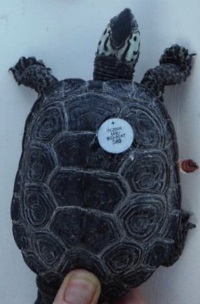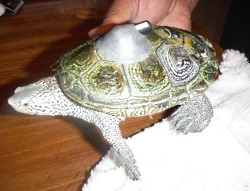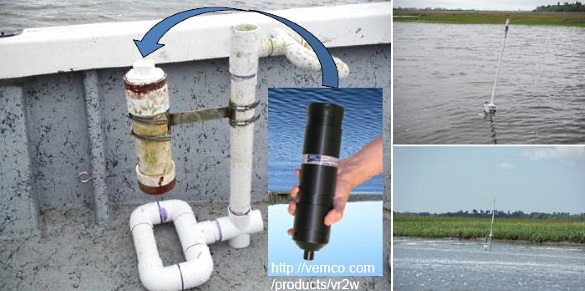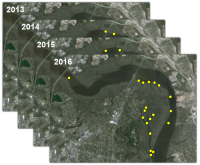Research - Distribution and movement patterns

Identification of terrapin distribution and movement patterns has mostly
been achieved through conventional tagging and acoustic telemetry.
Between 1999 and 2009, six graduate studies collectively marked and/or
tagged nearly 1,400 terrapins captured by the SCDNR trammel net
survey in the Charleston Harbor estuary
complex10, 12, 17-20.
Unfortunately, as is common in mark-recapture studies, less than 5% of these terrapins were recaptured, limiting information about distribution. However, some generalities emerged from these recapture events. For instance, all recaptures occurred in the same waterbody where terrapins were originally tagged, suggesting localization. Recaptures also mostly occurred between May and September, with the lowest relative recapture rates in June and July; these observations seem to suggest that terrapin vulnerability to capture in the trammel net survey varies seasonally, consistent with 75% of survey captures between April and June.

Recognizing the need to better understand the influences on terrapin vulnerability to capture in the trammel net survey as a precursor for interpreting survey catch rate trends over time, a four-year acoustic telemetry study was initiated in the Ashley River in 2013. This telemetry study built upon the research conducted with female terrapins in Grice Cove a decade earlier12, which revealed distinct tidal movements. In the present study, acoustic transmitters were attached to the carapace of diamondback terrapins (<300 g) using a fast-curing, two-part epoxy putty. Assessment of the effects of transmitter attachment on terrapin behavior and documentation of attachment duration was initiated in collaboration with the South Carolina Aquarium in October 2012, six months prior to commencing telemetry data collection with wild terrapins in April 2013.

Telemetry data was primarily collected through the strategic deployment of VR2W acoustic receivers at habitats of interest. Because the ability to hear a transmitter decreases with distance from the receiver, it was necessary to deploy these receivers close to the marsh edge where terrapins forage. As such, when the tide receded the receivers were no longer submerged (and also no longer able to detect terrapins); thus, to protect the receivers from prolonged exposure to the sun they were enclosed in PVC housings that moved up and down metal poles with the tide. Additional PVC poles were used to alert boaters to the presence of these submerged metal poles as well as to prevent the PVC housings from rotating. This remote data collection technique occurred daily, and every few months SCDNR researchers and volunteers would upload data from the receivers and clean the PVC housings.
In the first year of the study, the primary emphasis was to determine the extent of time that terrapins were detected in river (8 receivers) vs. small tidal creek (5 receivers) habitats surrounding Duck Island in the Ashley River. Based on the prevalence of detections associated with river receivers, in 2014, five additional acoustic receivers were deployed in 2014 in Orange Grove Creek which retained at least 5' of water in the main channel at low tide; two additional receivers were also placed across from Duck Island on the north side of the Ashley River. Based on continued but sporadic detections indicating along-river movement by terrapins, receivers in the creeks behind Duck Island were redistributed to provide additional riverine coverage in 2015. In fall 2015, all but one receiver located upriver from the Rt-7 Bridge was redistributed to the headwater creeks of Orange Grove Creek, the focus of terrapin telemetry research in 2016.
Through 2015, acoustic transmitters were attached to 26 female and 18 male diamondback terrapins after capture by SCDNR researchers, predominantly in the trammel net survey. Total detections were highly variable among individuals (from 49 to 28,230), but produced a data set with nearly 150,000 detections. Acoustic detection data collection spanned 13 to 378 days of observation per terrapin, with 50% of terrapins associated with at least 150 observation days. Detailed analysis of this data set is included in the 2013–2015 Grant Final Report, but several key findings emerged.
- First, females were detected as frequently as males; however, this overall observation reflected proportionally greater detection of females in May that offset proportionally reduced detection in most other months, notably July and August.
- Second, at least 80% of detections were associated with river habitats for 35 of 44 diamondback terrapins.
- Third, diamondback terrapins were detected by two to 17 acoustic receivers (most often seven), indicating a much higher degree of localized movement by individuals within the marsh complex than suggested by recapture data.
These findings collectively suggest that the trammel net survey is appropriate for monitoring catch rate trends for terrapins across South Carolina estuaries, but that data must be analyzed in the context of seasonal and environmental conditions that influence the probability of terrapins being present when surveys are conducted.

